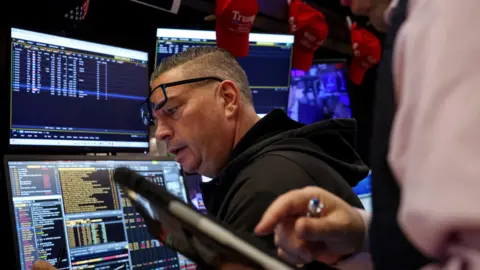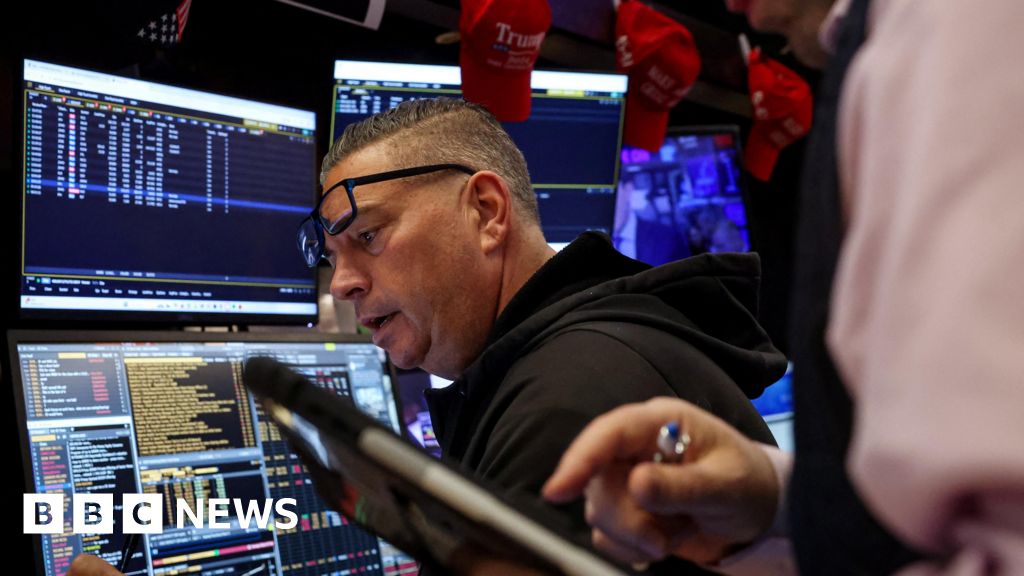Danielle KayeBusiness reporter
 Reuters
ReutersA burst of solid business news in the US was supposed to calm markets, which have been in retreat in recent weeks.
But strong sales at artificial intelligence (AI) chip giant Nvidia and the world’s largest retailer Walmart, better-than-expected hiring in September, and even a pickup in home sales have so far done little to quell investor worries.
The three biggest US stock indexes US resumed their slide on Thursday, reversing course after an early morning rally. The S&P 500 ended the day 1.5% lower, the Dow Jones Industrial Average fell 0.8% and the Nasdaq lost more than 2%.
Major stock markets in Asia also lost ground on Friday morning.
In New York, shares in Nvidia, which had surged in Thursday morning trading, fell by more than 3%.
“The reaction is noteworthy, because what should have happened, didn’t happen,” said James Stanley, a senior analyst at StoneX, referring to the sudden fade in the broader US market rally on Thursday.
“You’ve got to ask what’s happening under the surface.”
In Asia, Japan’s Nikkei 225 was down by nearly 2%, with technology investment giant Softbank plunging by more than 8%.
South Korea’s Kospi was down by 3.2%. Shares in chipmaker SK Hynix fell by almost 8% and Samsung was more than 4% lower.
Hong Kong’s Hang Seng opened around 2% lower.
The price of Bitcoin also fell on Thursday, extending recent declines and falling below $90,000 to its lowest since April. Analysts attributed the drop to, in part, concern about AI valuations.
Fears of an AI bubble continue to swirl, even though Nvidia’s results, which showed the chip giant powering on amid robust demand for its AI chips, briefly lifted stocks after-hours on Wednesday and early Thursday.
Chief executive Jensen Huang dismissed concerns that AI companies are overvalued. “From our vantage point, we see something very different,” he said on a call with analysts.
But fears on Wall Street persist, investment analysts said, despite Mr Huang’s reassurance and blockbuster results from the chip-maker, which is seen as a bellwether for the AI boom. Those fears have picked up this month.
Speaking to the BBC this month, Alphabet chief executive Sundar Pichai warned of some “irrationality” in the current AI boom.
Analysts with Oxford Economics said the recent technology draw-down signals “a healthy correction rather than the start of something more threatening”. Earlier this week, they warned that tech stocks might suffer from profit taking in the near term, but noted that “it’s too early to call an end to the AI investment boom”.
At the same time, investors remain on edge about the path forward for interest rates. They are still awaiting key inflation data that had been delayed during the US government shutdown, which could inform the Federal Reserve’s pace of cuts into next year.
The S&P 500 index is more than 4% lower so far in November, putting it on track for its worst month since March.
Investors, Mr Stanley said, are “squaring up” as they grapple with uncertainty about the state of the economy, and whether the Fed will be forced to keep interest rates higher if inflation heats up.
“There’s a lot of trepidation about where inflation is,” he said. “There’s a lot of opacity.”
Thursday’s jobs report did little to offer clarity on the Fed’s upcoming decisions about interest rates, said Eric Teal, chief investment officer at Comerica Bank.
While employers added 119,000 jobs in September – more than double what many analysts had expected – the unemployment rate ticked up from 4.3% to 4.4%, the Labor Department figures showed. The mixed data, analysts said, leaves more questions than answers about whether the Fed will cut at their next meeting in December, and into 2026.
Mr Teal pointed to continued AI adoption and lower interest rates as two key aspects of the economic backdrop that need to remain intact in order to keep propelling stocks to new highs.
Growing jitters about an AI bubble and inflation could inject even more volatility into financial markets beyond this month, he added.
“When you have a market that’s priced at perfection, you need all of the external catalysts behind it to keep driving it higher,” Mr Teal said.
“A lot of those things, over the past three weeks, have been called into question.”










